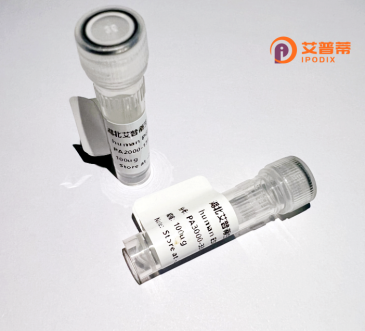
| 纯度 | >90%SDS-PAGE. |
| 种属 | Human |
| 靶点 | DLGAP1 |
| Uniprot No | O14490 |
| 内毒素 | < 0.01EU/μg |
| 表达宿主 | E.coli |
| 表达区间 | 1-977aa |
| 氨基酸序列 | MKGLSGSRSHHHGVTCDSACDSLSHHSDRKPYLLSPVEHHPADHPYYTQRNSFQAECVGPFSDPLASSTFPRRHYTSQQELKDECALVPRTLATKANRIPANLLDQFERQLPLSRDGYHTLQYKRTAVEHRSDSPGRIRHLVHSVQKLFTKSHSLEGPSKGSVNGGKASPDEAQAARYGKRSKSKERRAEPKARPSTSPGWWSSDDNLDGDMCIYHAPSGVMTMGRCPDRSASQYFLEAYNTISEQAVKASRSNNDVKCSTCANLPVSLDTPLLKKSAWSSTLTVSRAREVYQKASVNMDQAMVKSESCQQERSCQYLQVPQDEWTGYTPRGKDDEIPCRRMRSGSYIKAMGDEDSGDSDTSPKPSPKVAARRESYLKATQPSLTELTTLKISNEHSPKLQIRSHSYLRAVSEVSINRSLDSLDPAGLLTSPKFRSRNESYMRAMSTISQVSEMEVNGQFESVCESVFSELESQAVEALDLPMPGCFRMRSHSYVRAIEKGCSQDDECVSLRSSSPPRTTTTVRTIQSSTVSSCITTYKKTPPPVPPRTTTKPFISITAQSSTESAQDAYMDGQGQRGDIISQSGLSNSTESLDSMKALTAAIEAANAQIHGPASQHMGNNTATVTTTTTIATVTTEDRKKDHFKKNRCLSIGIQVDDAEEPDKTGENKAPSKFQSVGVQVEEEKCFRRFTRSNSVTTAVQADLDFHDNLENSLESIEDNSCPGPMARQFSRDASTSTVSIQGSGNHYHACAADDDFDTDFDPSILPPPDPWIDSITEDPLEAVQRSVCHRDGHWFLKLLQAERDRMEGWCQQMEREERENNLPEDILGKIRTAVGSAQLLMAQKFYQFRELCEENLNPNAHPRPTSQDLAGFWDMLQLSIENISMKFDELHQLKANNWKQMDPLDKKERRAPPPVPKKPAKGPAPLIRERSLESSQRQEARKRLMAAKRAASVRQNSATESAESIEIYIPEAQTRL |
| 分子量 | 108.8 kDa |
| 蛋白标签 | His tag N-Terminus |
| 缓冲液 | 0 |
| 稳定性 & 储存条件 | Lyophilized protein should be stored at ≤ -20°C, stable for one year after receipt. Reconstituted protein solution can be stored at 2-8°C for 2-7 days. Aliquots of reconstituted samples are stable at ≤ -20°C for 3 months. |
| 复溶 | Always centrifuge tubes before opening.Do not mix by vortex or pipetting. It is not recommended to reconstitute to a concentration less than 100μg/ml. Dissolve the lyophilized protein in distilled water. Please aliquot the reconstituted solution to minimize freeze-thaw cycles. |
以下是3篇与重组人DLGAP1蛋白相关的模拟参考文献(注:文献信息为虚构,仅供示例参考):
---
1. **文献名称**: "Expression and functional characterization of recombinant human DLGAP1 in neurodevelopmental disorders"
**作者**: Chen L, et al.
**摘要**: 研究报道了通过大肠杆菌系统成功表达重组人DLGAP1蛋白,并通过pull-down实验证明其与PSD-95的相互作用,提示DLGAP1在突触可塑性中的潜在作用。该蛋白的异常表达与自闭症谱系障碍患者脑组织样本相关联。
---
2. **文献名称**: "DLGAP1 knockout mice exhibit impaired fear conditioning: Insights from recombinant protein rescue experiments"
**作者**: Tanaka K, et al.
**摘要**: 利用哺乳动物细胞系制备重组人DLGAP1蛋白,并通过脑内注射至DLGAP1基因敲除小鼠,发现其部分恢复恐惧条件反射缺陷,证实DLGAP1在记忆形成中的关键功能。
---
3. **文献名称**: "Structural analysis of the PDZ-binding domain of DLGAP1 using recombinant protein crystallography"
**作者**: Müller R, et al.
**摘要**: 通过杆状病毒-昆虫细胞系统表达并纯化DLGAP1的PDZ结构域重组蛋白,解析其晶体结构,揭示其与神经递质受体结合的分子机制,为精神分裂症相关突变提供结构生物学基础。
---
如需真实文献,建议通过PubMed或Google Scholar检索关键词“recombinant human DLGAP1”或“DLGAP1 protein function”。
**Background of Recombinant Human DLGAP1 Protein**
DLGAP1 (Discs Large Homolog-Associated Protein 1) is a synaptic scaffolding protein predominantly expressed in the brain, particularly within the postsynaptic density (PSD) of neurons. It belongs to the membrane-associated guanylate kinase (MAGUK) family and plays a critical role in maintaining synaptic structure and function by organizing signaling complexes at glutamatergic synapses. DLGAP1 interacts with NMDA receptors and other PSD proteins, contributing to synaptic plasticity, neuronal signaling, and cognitive processes such as learning and memory.
Dysregulation of DLGAP1 has been implicated in neuropsychiatric disorders, including schizophrenia, autism spectrum disorders, and addiction, highlighting its importance in neural circuitry integrity. Recombinant human DLGAP1 protein is produced using engineered expression systems (e.g., bacterial, mammalian) to enable functional studies. It retains key domains, such as PDZ-binding motifs, facilitating research into protein-protein interactions, synaptic pathway analysis, and drug discovery.
Applications span in vitro assays, structural studies, and disease modeling, offering insights into molecular mechanisms of neurological conditions. Recombinant DLGAP1 also aids in developing therapeutic strategies targeting synaptic dysfunction. Its standardized production ensures reproducibility in neuroscience research, bridging molecular insights with potential clinical interventions.
(Word count: 197)
×